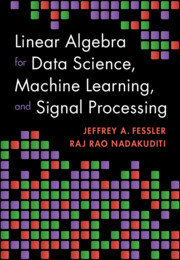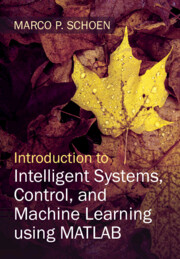268 results
21 - Hydrologic Modeling
-
- Book:
- Applied Hydrology
- Print publication:
- 04 July 2024, pp 683-723
-
- Chapter
- Export citation

Linear Algebra for Data Science, Machine Learning, and Signal Processing
- Coming soon
-
- Expected online publication date:
- June 2024
- Print publication:
- 16 May 2024
-
- Textbook
- Export citation
Optimizing insurance risk assessment: a regression model based on a risk-loaded approach
-
- Journal:
- Annals of Actuarial Science , First View
- Published online by Cambridge University Press:
- 31 May 2024, pp. 1-14
-
- Article
-
- You have access
- Open access
- HTML
- Export citation
Robot base placement and tool mounting optimization based on capability map for robot-assistant camera holder
-
- Journal:
- Robotica , First View
- Published online by Cambridge University Press:
- 27 May 2024, pp. 1-22
-
- Article
- Export citation
Minimizing occupant loads in vehicle crashes through reinforcement learning-based restraint system design: assessing performance and transferability
-
- Journal:
- Proceedings of the Design Society / Volume 4 / May 2024
- Published online by Cambridge University Press:
- 16 May 2024, pp. 2139-2148
-
- Article
-
- You have access
- Open access
- Export citation
37 - Education and the Technological Horizon
- from Part III - Emerging Ethical Pathways and Frameworks
-
-
- Book:
- The Cambridge Handbook of Ethics and Education
- Published online:
- 07 March 2024
- Print publication:
- 14 March 2024, pp 777-796
-
- Chapter
- Export citation
1 - Human Behavioral Ecology
-
-
- Book:
- Human Behavioral Ecology
- Published online:
- 07 March 2024
- Print publication:
- 14 March 2024, pp 1-19
-
- Chapter
- Export citation
Design of a wearable shoulder exoskeleton robot with dual-purpose gravity compensation and a compliant misalignment compensation mechanism
-
- Journal:
- Wearable Technologies / Volume 5 / 2024
- Published online by Cambridge University Press:
- 12 February 2024, e4
-
- Article
-
- You have access
- Open access
- HTML
- Export citation
Application of Box—Behnken Design to Modeling the Effect of Smectite Content on Swelling to Hydrocyclone Processing of Bentonites with Various Geologic Properties
-
- Journal:
- Clays and Clay Minerals / Volume 58 / Issue 3 / June 2010
- Published online by Cambridge University Press:
- 01 January 2024, pp. 431-448
-
- Article
- Export citation
Tracer Diffusion in Sintered Stainless Steel Filters: Measurement of Effective Diffusion Coefficients and Implications for Diffusion Studies with Compacted Clays
-
- Journal:
- Clays and Clay Minerals / Volume 56 / Issue 6 / December 2008
- Published online by Cambridge University Press:
- 01 January 2024, pp. 677-685
-
- Article
- Export citation
Error propagation and attribution in simulation-based capital models
-
- Journal:
- Annals of Actuarial Science / Volume 18 / Issue 1 / March 2024
- Published online by Cambridge University Press:
- 28 November 2023, pp. 176-204
-
- Article
-
- You have access
- Open access
- HTML
- Export citation

Introduction to Intelligent Systems, Control, and Machine Learning using MATLAB
-
- Published online:
- 27 November 2023
- Print publication:
- 16 November 2023
-
- Textbook
- Export citation
Methodology for shape prediction and conversion of a conventional aerofoil to an inflatable baffled aerofoil
-
- Journal:
- The Aeronautical Journal / Volume 128 / Issue 1323 / May 2024
- Published online by Cambridge University Press:
- 03 November 2023, pp. 1037-1070
-
- Article
-
- You have access
- Open access
- HTML
- Export citation
Numerical investigation of the dynamic stall reduction on the UAS-S45 aerofoil using the optimised aerofoil method
-
- Journal:
- The Aeronautical Journal / Volume 128 / Issue 1321 / March 2024
- Published online by Cambridge University Press:
- 22 September 2023, pp. 441-468
-
- Article
-
- You have access
- Open access
- HTML
- Export citation
3 - Likelihoods and Latent Variables
- from Part I - Concepts from Modeling, Inference, and Computing
-
- Book:
- Data Modeling for the Sciences
- Published online:
- 17 August 2023
- Print publication:
- 31 August 2023, pp 108-130
-
- Chapter
- Export citation
A comparative analysis of machine learning approach for optimizing antenna design
-
- Journal:
- International Journal of Microwave and Wireless Technologies , First View
- Published online by Cambridge University Press:
- 29 August 2023, pp. 1-11
-
- Article
-
- You have access
- Open access
- HTML
- Export citation
19 - Data Assimilation in Geodynamics: Methods and Applications
- from Part III - ‘Solid’ Earth Applications: From the Surface to the Core
-
-
- Book:
- Applications of Data Assimilation and Inverse Problems in the Earth Sciences
- Published online:
- 20 June 2023
- Print publication:
- 06 July 2023, pp 293-310
-
- Chapter
- Export citation
Optimal commissions and subscriptions in mutual aid platforms
-
- Journal:
- ASTIN Bulletin: The Journal of the IAA / Volume 53 / Issue 3 / September 2023
- Published online by Cambridge University Press:
- 04 July 2023, pp. 658-683
- Print publication:
- September 2023
-
- Article
- Export citation
Guidance on selecting a translational framework for intervention development: Optimizing interventions for impact
-
- Journal:
- Journal of Clinical and Translational Science / Volume 7 / Issue 1 / 2023
- Published online by Cambridge University Press:
- 11 May 2023, e119
-
- Article
-
- You have access
- Open access
- HTML
- Export citation













